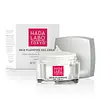What's inside
What's inside
 Key Ingredients
Key Ingredients

 Benefits
Benefits

 Concerns
Concerns

 Ingredients Side-by-side
Ingredients Side-by-side

Niacinamide
SmoothingWater
Skin ConditioningButylene Glycol
HumectantGlycerin
HumectantAlcohol Denat.
AntimicrobialCetyl Ethylhexanoate
EmollientHydrogenated Egg Oil
Skin ConditioningHydrogenated Phosphatidylcholine
EmulsifyingDipentaerythrityl Hexa C5-10 Acid Esters
Dimethicone
EmollientN-Stearoyl-Dihydrosphingosine
Skin ConditioningTocopherol
AntioxidantHexyldecyl Hexyldecanoate
EmollientSodium Hyaluronate
HumectantElastin
Skin ConditioningMyristoyl Succinoyl Atelocollagen
Skin ConditioningMagnesium Ascorbyl Phosphate
AntioxidantCollagen Powder
HumectantHydrolyzed Silk
HumectantHydrolyzed Hyaluronic Acid
HumectantSoluble Collagen
HumectantPhytosteryl/Octyldodecyl Lauroyl Glutamate
Skin ConditioningAcrylic Acid
Isostearic Acid
CleansingDisodium EDTA
Polyvinylalcohol Crosspolymer
Cholesterol
EmollientBifida Polysaccharide
HumectantDi-T-Butylhydroquinone
AntioxidantC23-43 Acid Pentaerythritol Tetraester
EmollientDecyltetradeceth-20
EmulsifyingPotassium Laurate
EmulsifyingDisodium Phosphate
BufferingCalcium Dihydrogen Phosphate
BufferingPetrolatum
EmollientSodium Hydroxide
BufferingPhenoxyethanol
PreservativeMethylparaben
PreservativeParfum
MaskingCaramel
Cosmetic ColorantNiacinamide, Water, Butylene Glycol, Glycerin, Alcohol Denat., Cetyl Ethylhexanoate, Hydrogenated Egg Oil, Hydrogenated Phosphatidylcholine, Dipentaerythrityl Hexa C5-10 Acid Esters, Dimethicone, N-Stearoyl-Dihydrosphingosine, Tocopherol, Hexyldecyl Hexyldecanoate, Sodium Hyaluronate, Elastin, Myristoyl Succinoyl Atelocollagen, Magnesium Ascorbyl Phosphate, Collagen Powder, Hydrolyzed Silk, Hydrolyzed Hyaluronic Acid, Soluble Collagen, Phytosteryl/Octyldodecyl Lauroyl Glutamate, Acrylic Acid, Isostearic Acid, Disodium EDTA, Polyvinylalcohol Crosspolymer, Cholesterol, Bifida Polysaccharide, Di-T-Butylhydroquinone, C23-43 Acid Pentaerythritol Tetraester, Decyltetradeceth-20, Potassium Laurate, Disodium Phosphate, Calcium Dihydrogen Phosphate, Petrolatum, Sodium Hydroxide, Phenoxyethanol, Methylparaben, Parfum, Caramel
Water
Skin ConditioningHydroxyethyl Urea
HumectantButylene Glycol
HumectantGlycerin
HumectantPentylene Glycol
Skin ConditioningPEG/PPG/Polybutylene Glycol-8/5/3 Glycerin
HumectantSqualane
EmollientTriethylhexanoin
MaskingAmmonium Acryloyldimethyltaurate/Vp Copolymer
Agar
MaskingAlpha-Glucan
HumectantArginine
MaskingCitric Acid
BufferingDimethicone
EmollientDipropylene Glycol
HumectantDisodium EDTA
Glucosyl Ceramide
Skin ConditioningHydrolyzed Collagen
EmollientHydrolyzed Hyaluronic Acid
HumectantIodopropynyl Butylcarbamate
PreservativeMethylisothiazolinone
PreservativeSodium Acetylated Hyaluronate
HumectantSodium Chloride
MaskingSodium Citrate
BufferingSodium Hyaluronate
HumectantTriethyl Citrate
MaskingWater, Hydroxyethyl Urea, Butylene Glycol, Glycerin, Pentylene Glycol, PEG/PPG/Polybutylene Glycol-8/5/3 Glycerin, Squalane, Triethylhexanoin, Ammonium Acryloyldimethyltaurate/Vp Copolymer, Agar, Alpha-Glucan, Arginine, Citric Acid, Dimethicone, Dipropylene Glycol, Disodium EDTA, Glucosyl Ceramide, Hydrolyzed Collagen, Hydrolyzed Hyaluronic Acid, Iodopropynyl Butylcarbamate, Methylisothiazolinone, Sodium Acetylated Hyaluronate, Sodium Chloride, Sodium Citrate, Sodium Hyaluronate, Triethyl Citrate
Ingredients Explained
These ingredients are found in both products.
Ingredients higher up in an ingredient list are typically present in a larger amount.
Butylene Glycol (or BG) is used within cosmetic products for a few different reasons:
Overall, Butylene Glycol is a safe and well-rounded ingredient that works well with other ingredients.
Though this ingredient works well with most skin types, some people with sensitive skin may experience a reaction such as allergic rashes, closed comedones, or itchiness.
Learn more about Butylene GlycolDimethicone is a type of synthetic silicone created from natural materials such as quartz.
What it does:
Dimethicone comes in different viscosities:
Depending on the viscosity, dimethicone has different properties.
Ingredients lists don't always show which type is used, so we recommend reaching out to the brand if you have questions about the viscosity.
This ingredient is unlikely to cause irritation because it does not get absorbed into skin. However, people with silicone allergies should be careful about using this ingredient.
Note: Dimethicone may contribute to pilling. This is because it is not oil or water soluble, so pilling may occur when layered with products. When mixed with heavy oils in a formula, the outcome is also quite greasy.
Learn more about DimethiconeDisodium EDTA plays a role in making products more stable by aiding other preservatives.
It is a chelating agent, meaning it neutralizes metal ions that may be found in a product.
Disodium EDTA is a salt of edetic acid and is found to be safe in cosmetic ingredients.
Learn more about Disodium EDTAGlycerin is already naturally found in your skin. It helps moisturize and protect your skin.
A study from 2016 found glycerin to be more effective as a humectant than AHAs and hyaluronic acid.
As a humectant, it helps the skin stay hydrated by pulling moisture to your skin. The low molecular weight of glycerin allows it to pull moisture into the deeper layers of your skin.
Hydrated skin improves your skin barrier; Your skin barrier helps protect against irritants and bacteria.
Glycerin has also been found to have antimicrobial and antiviral properties. Due to these properties, glycerin is often used in wound and burn treatments.
In cosmetics, glycerin is usually derived from plants such as soybean or palm. However, it can also be sourced from animals, such as tallow or animal fat.
This ingredient is organic, colorless, odorless, and non-toxic.
Glycerin is the name for this ingredient in American English. British English uses Glycerol/Glycerine.
Learn more about GlycerinHydrolyzed Hyaluronic Acid is a form of hyaluronic acid. It is created by the hydrolysis of hyaluronic acid with a high molecular weight. Once created, Hydrolyzed Hyaluronic Acid has a low molecular weight.
Low molecular weight HA has been shown to hydrate and increase elasticity of the skin. Increasing elasticity is also associated with reduction of wrinkle depth.
One study found topical low molecular weight hyaluronic acid may be considered for the treatment of rosacea in the adult population. However, we always recommend speaking with a professional about your skin concerns.
Hyaluronic acids are a humectant. This means they draw moisture from the air. Hyaluronic acids help moisturize, soothe, and protect the skin.
Read more about other common forms of hyaluronic acid:
Learn more about Hydrolyzed Hyaluronic AcidSodium Hyaluronate is hyaluronic acid's salt form. It is commonly derived from the sodium salt of hyaluronic acid.
Like hyaluronic acid, it is great at holding water and acts as a humectant. This makes it a great skin hydrating ingredient.
Sodium Hyaluronate is naturally occurring in our bodies and is mostly found in eye fluid and joints.
These are some other common types of Hyaluronic Acid:
Learn more about Sodium HyaluronateWater. It's the most common cosmetic ingredient of all. You'll usually see it at the top of ingredient lists, meaning that it makes up the largest part of the product.
So why is it so popular? Water most often acts as a solvent - this means that it helps dissolve other ingredients into the formulation.
You'll also recognize water as that liquid we all need to stay alive. If you see this, drink a glass of water. Stay hydrated!
Learn more about Water